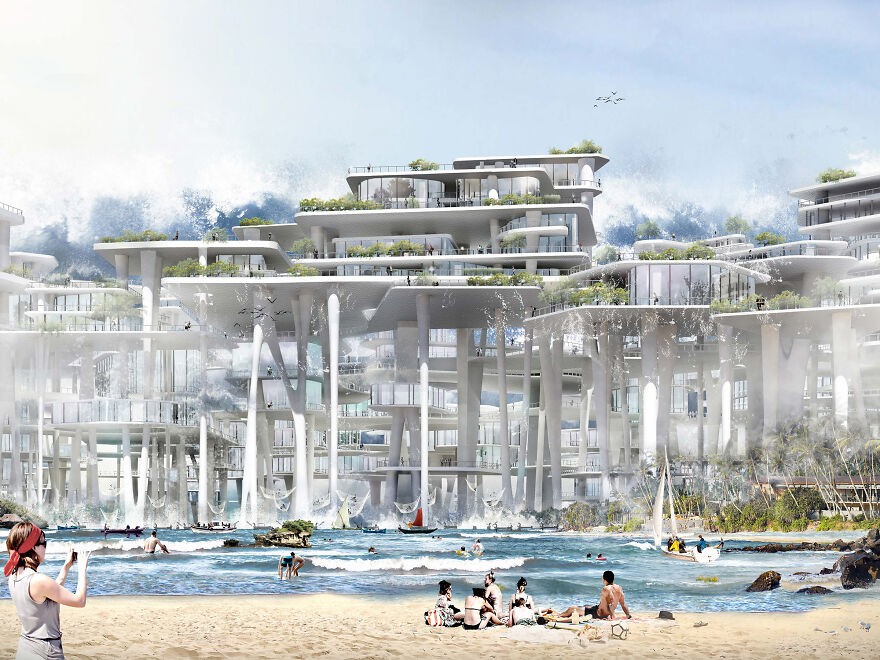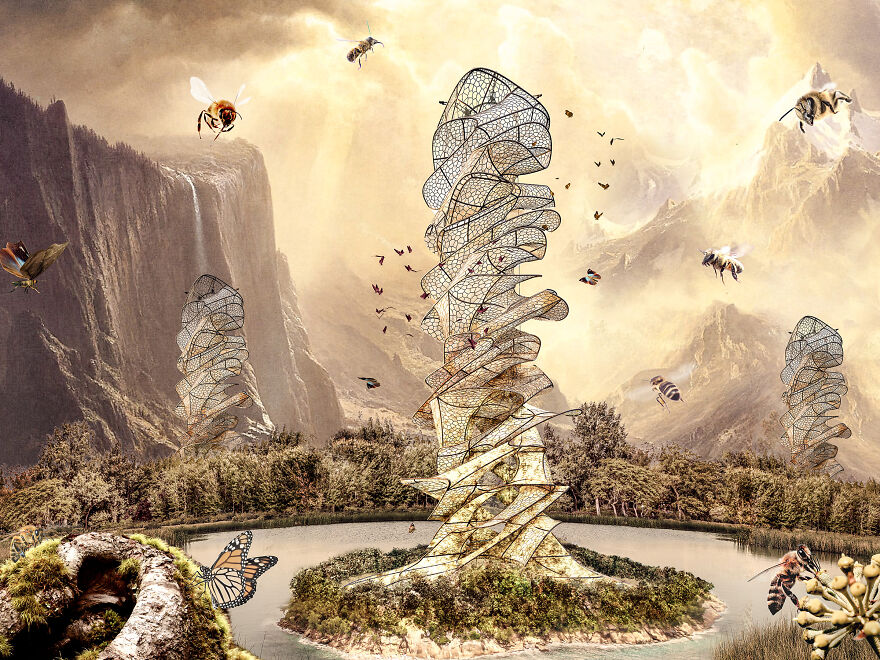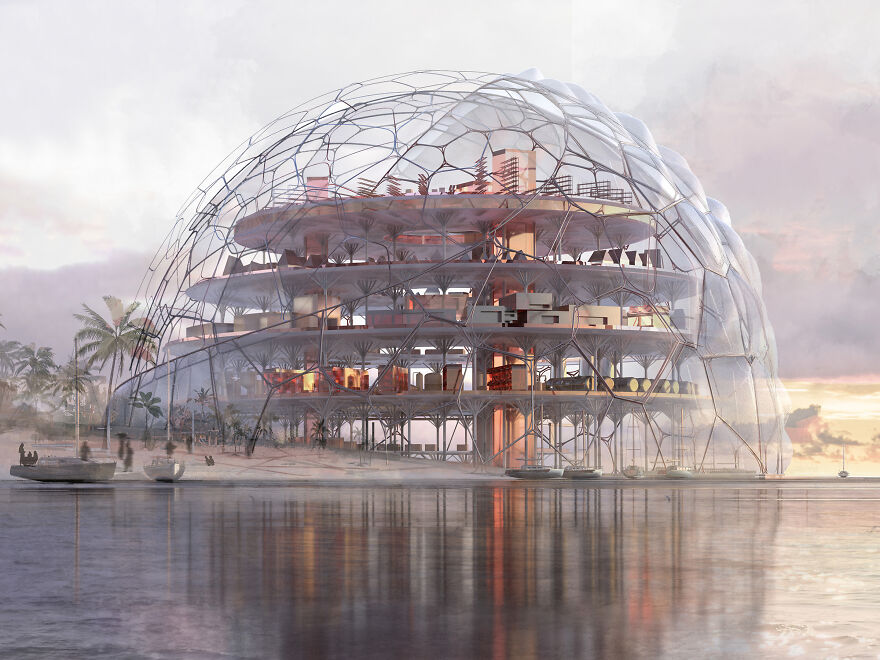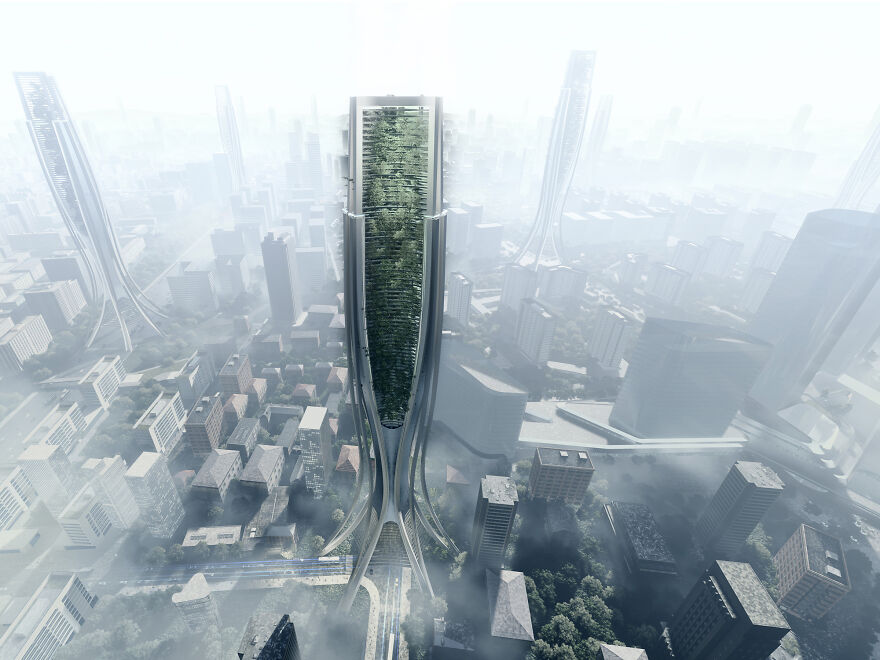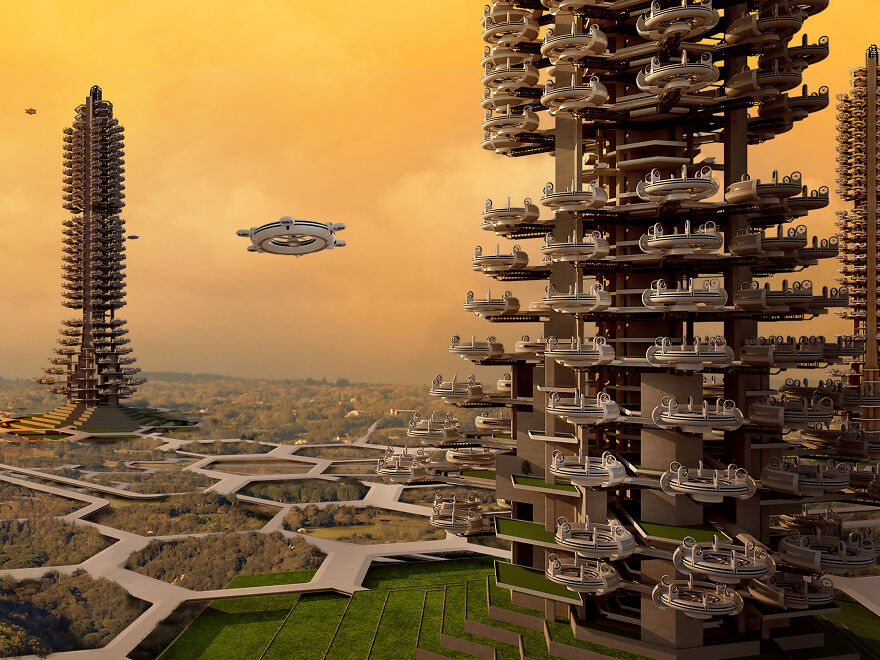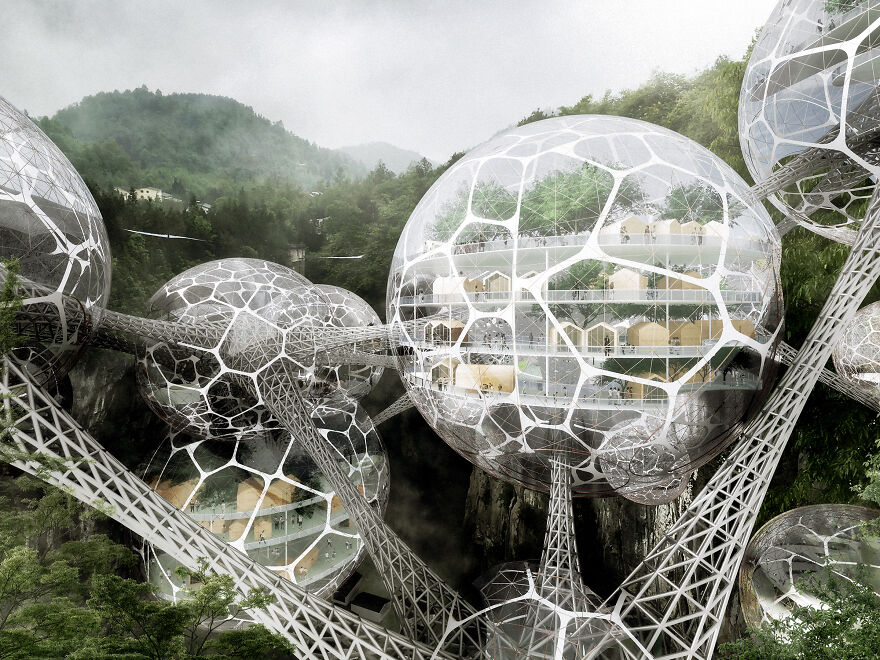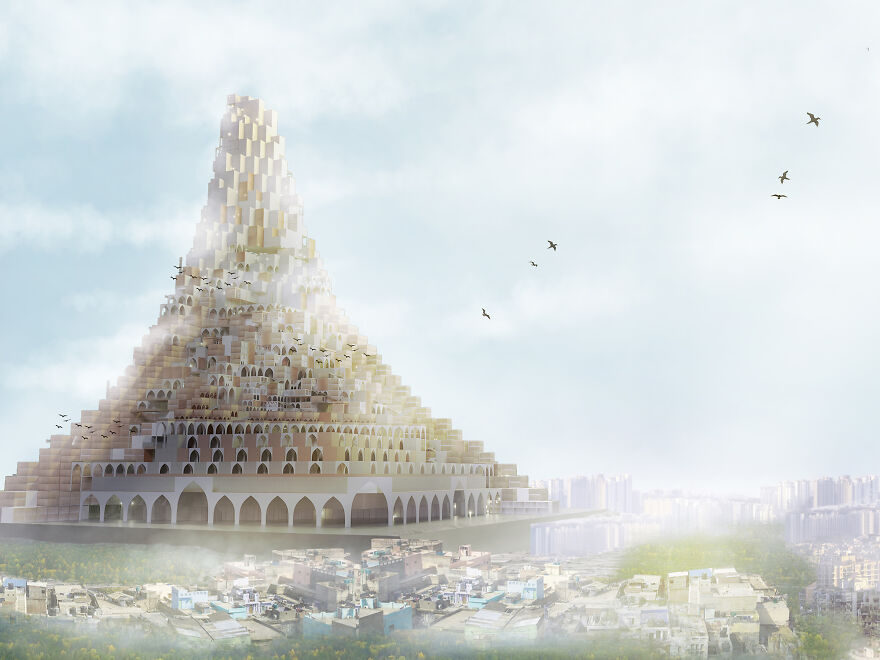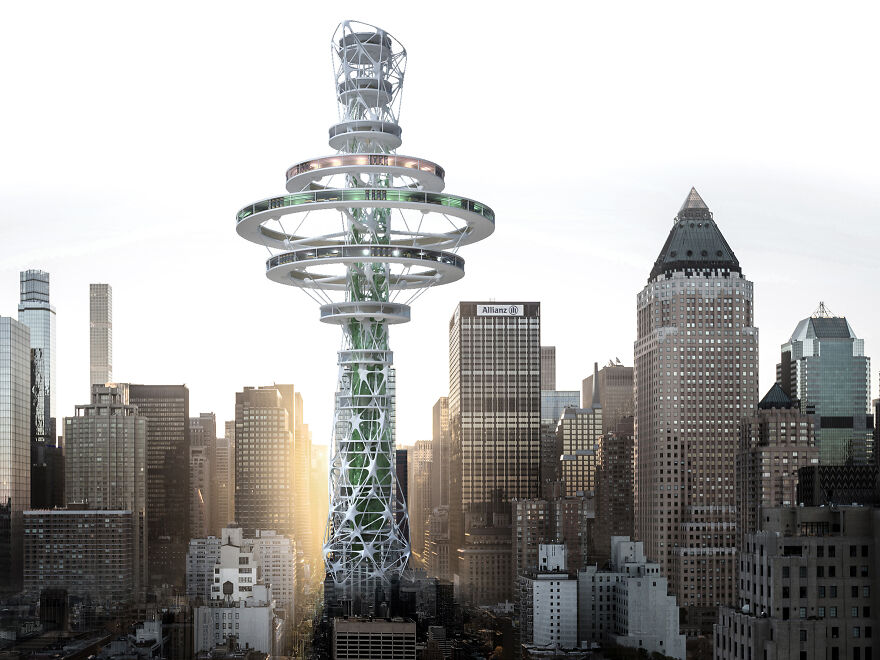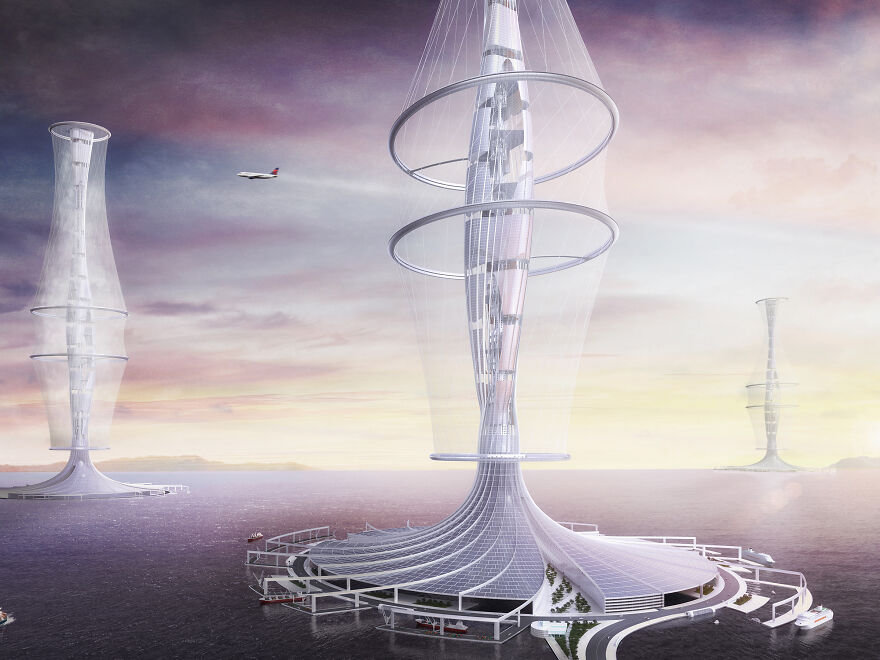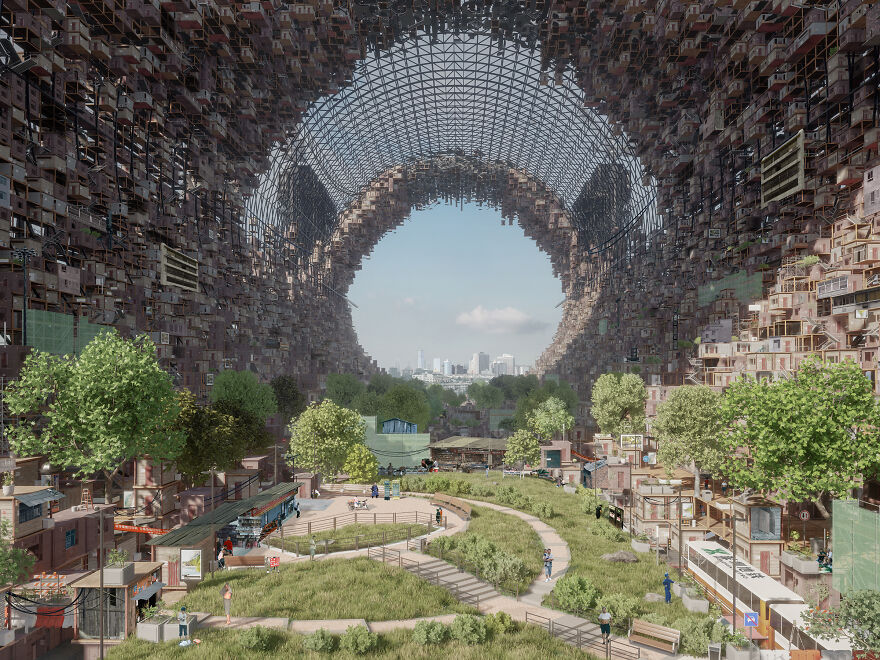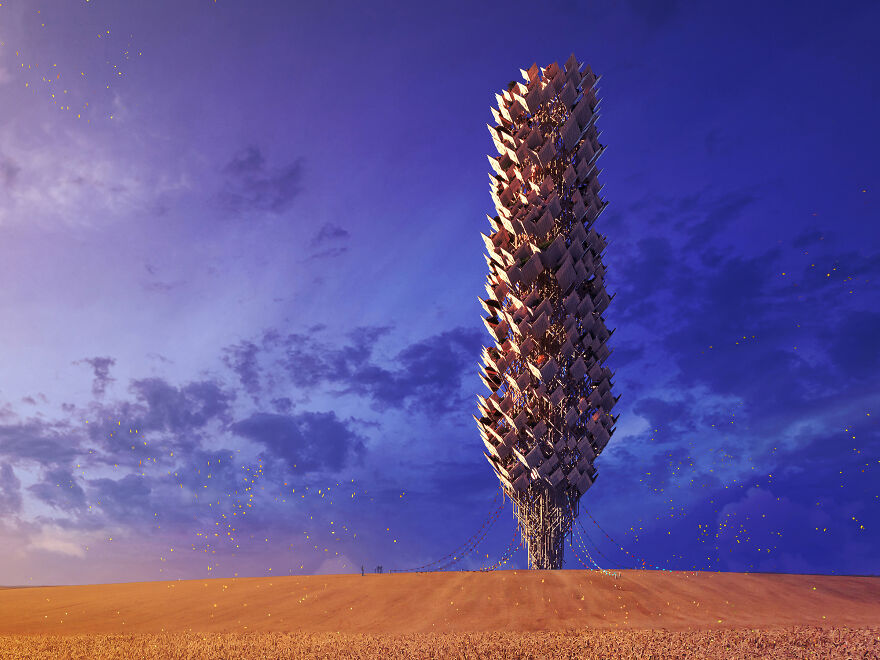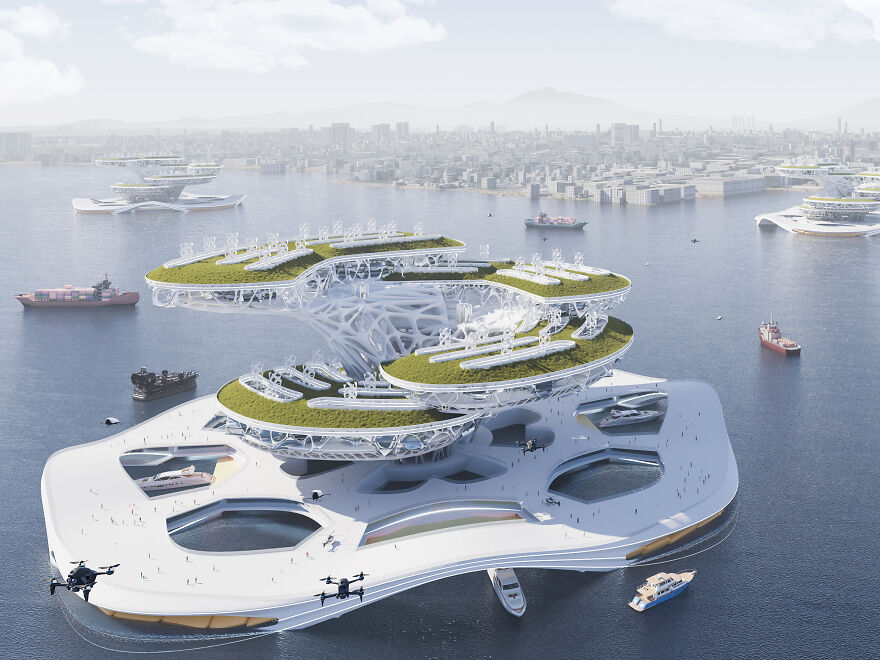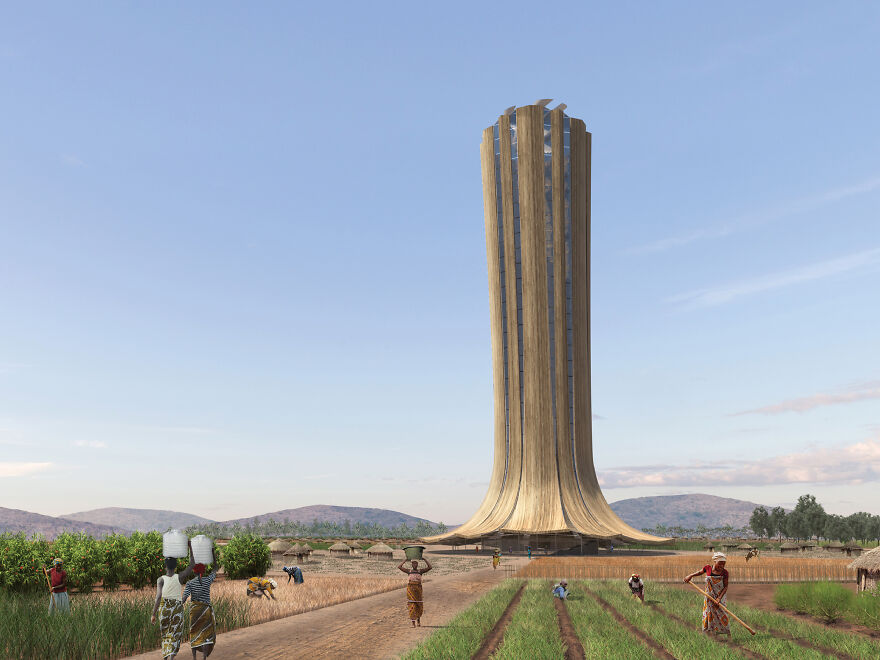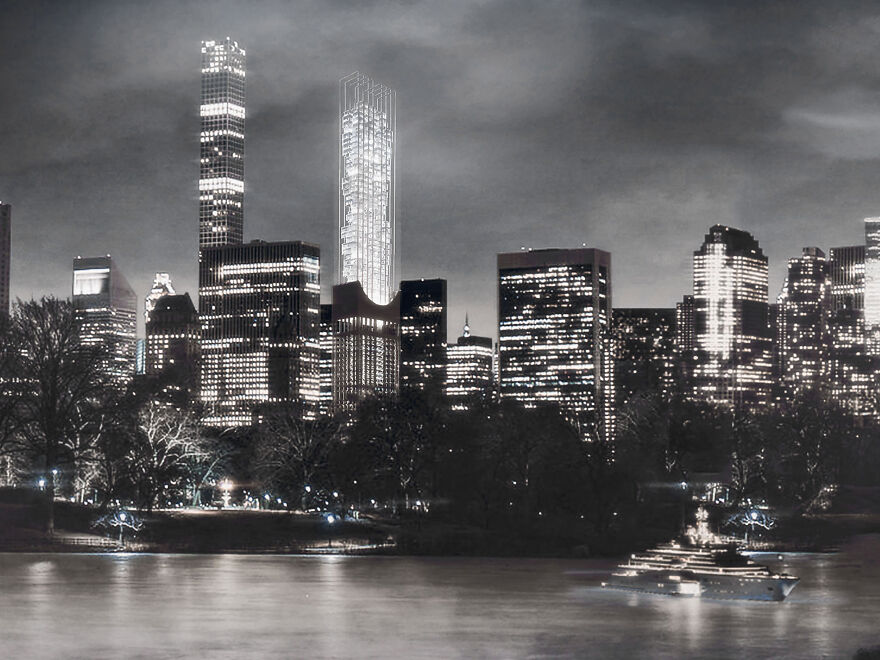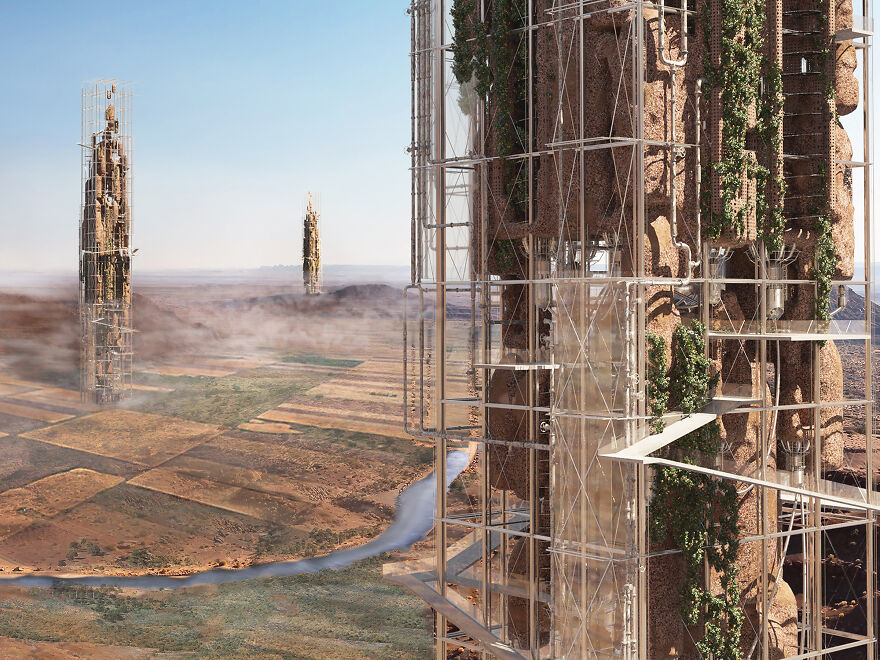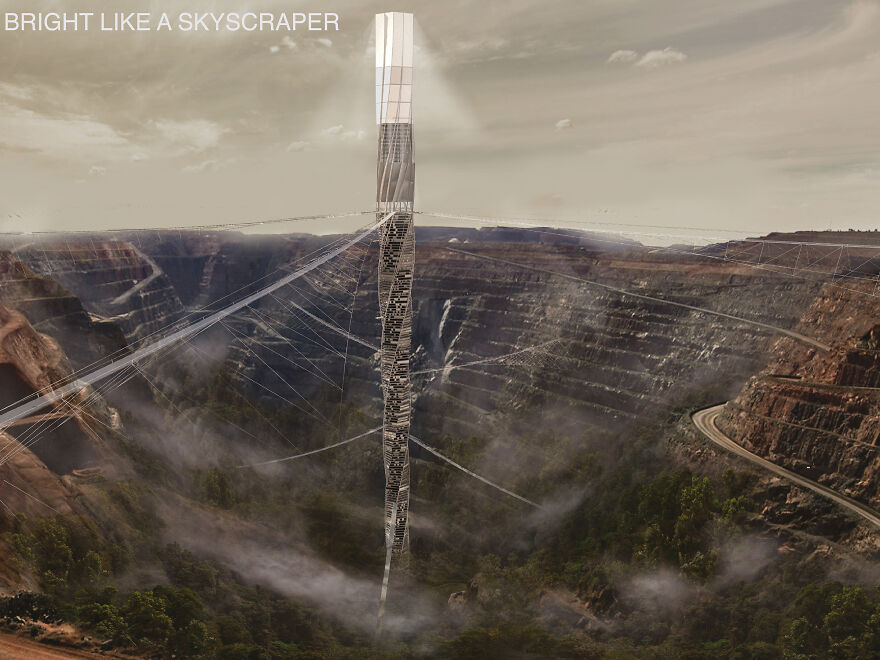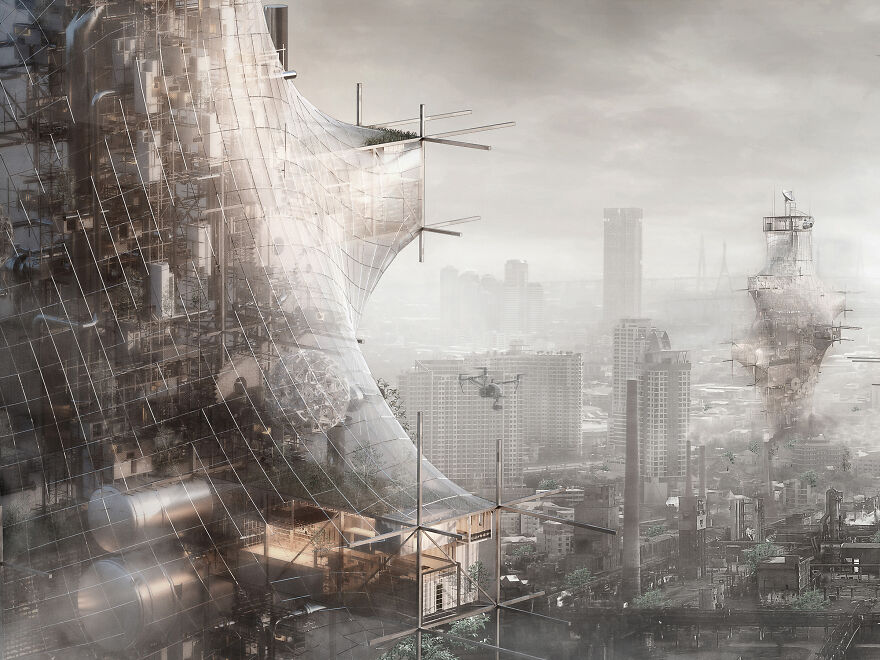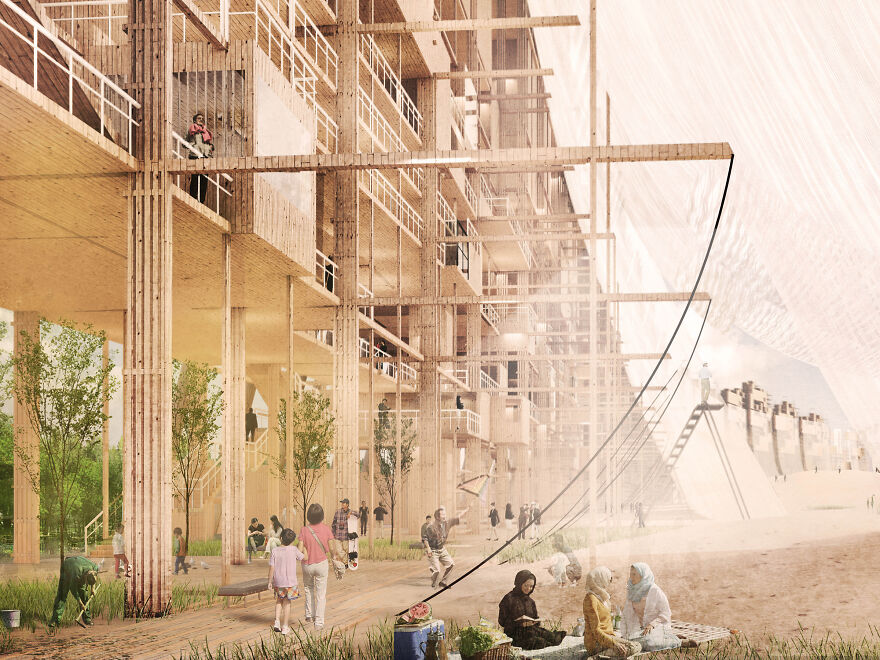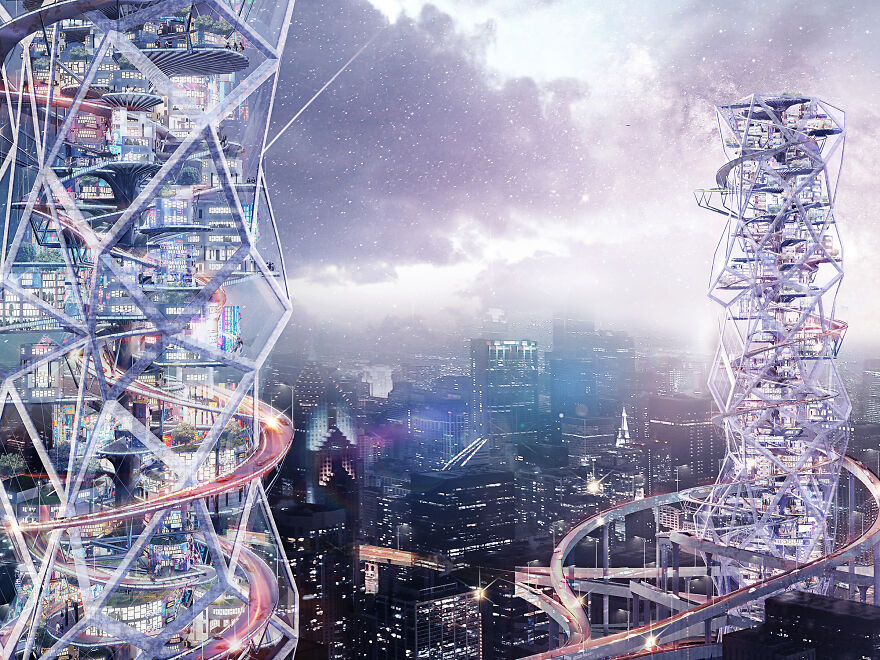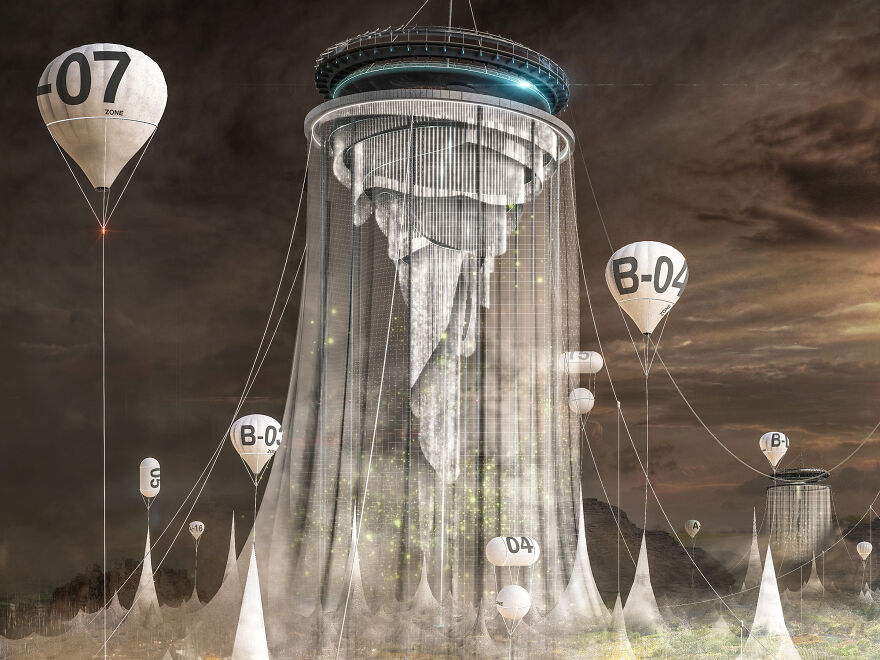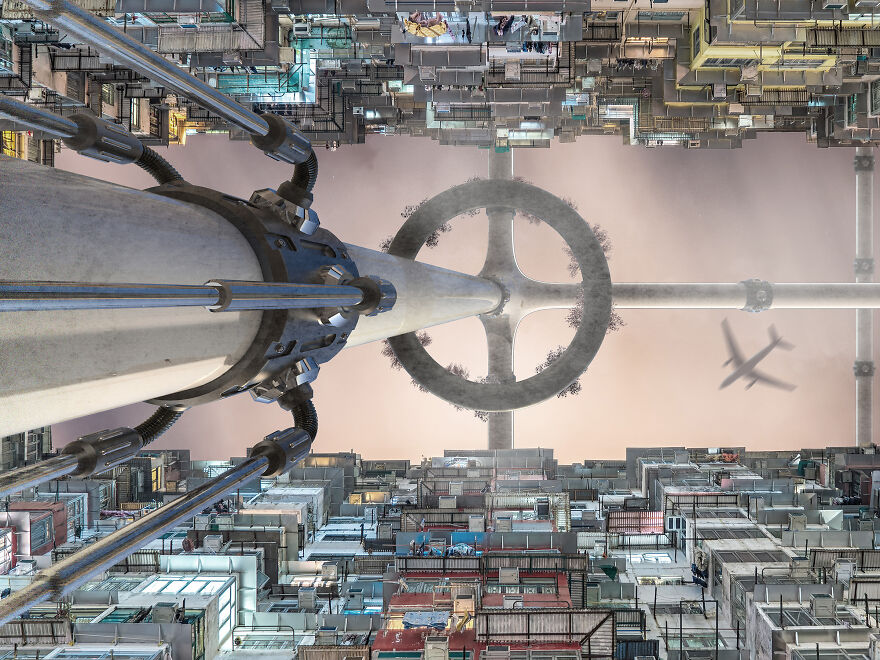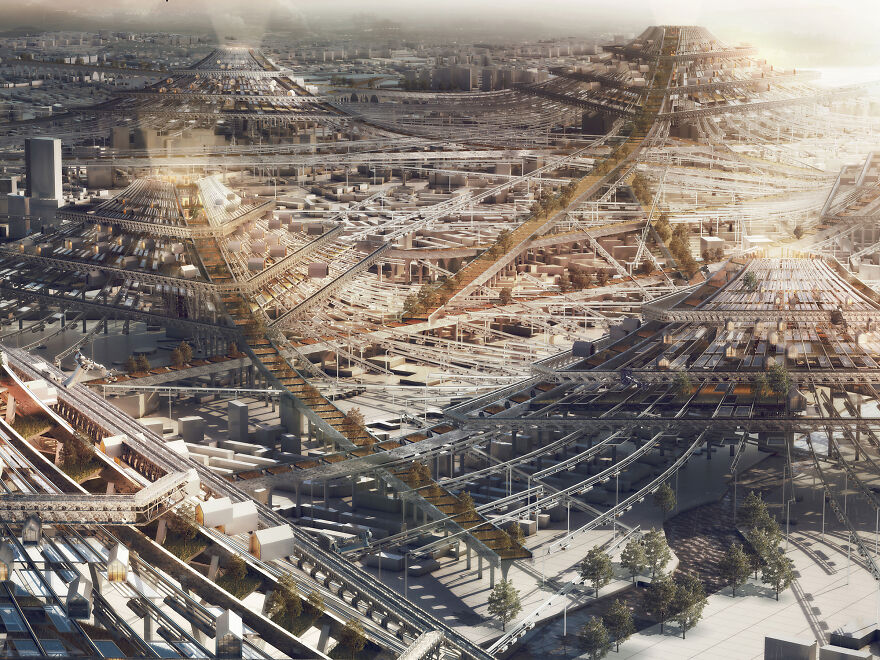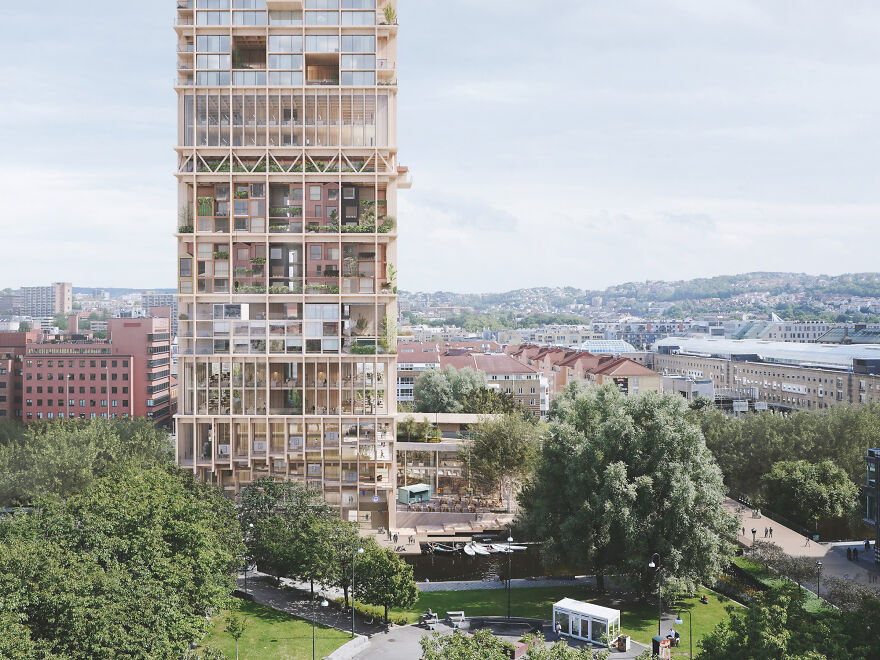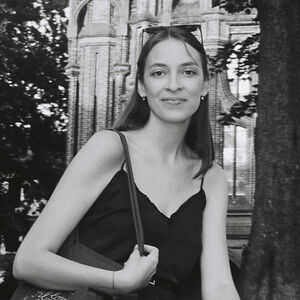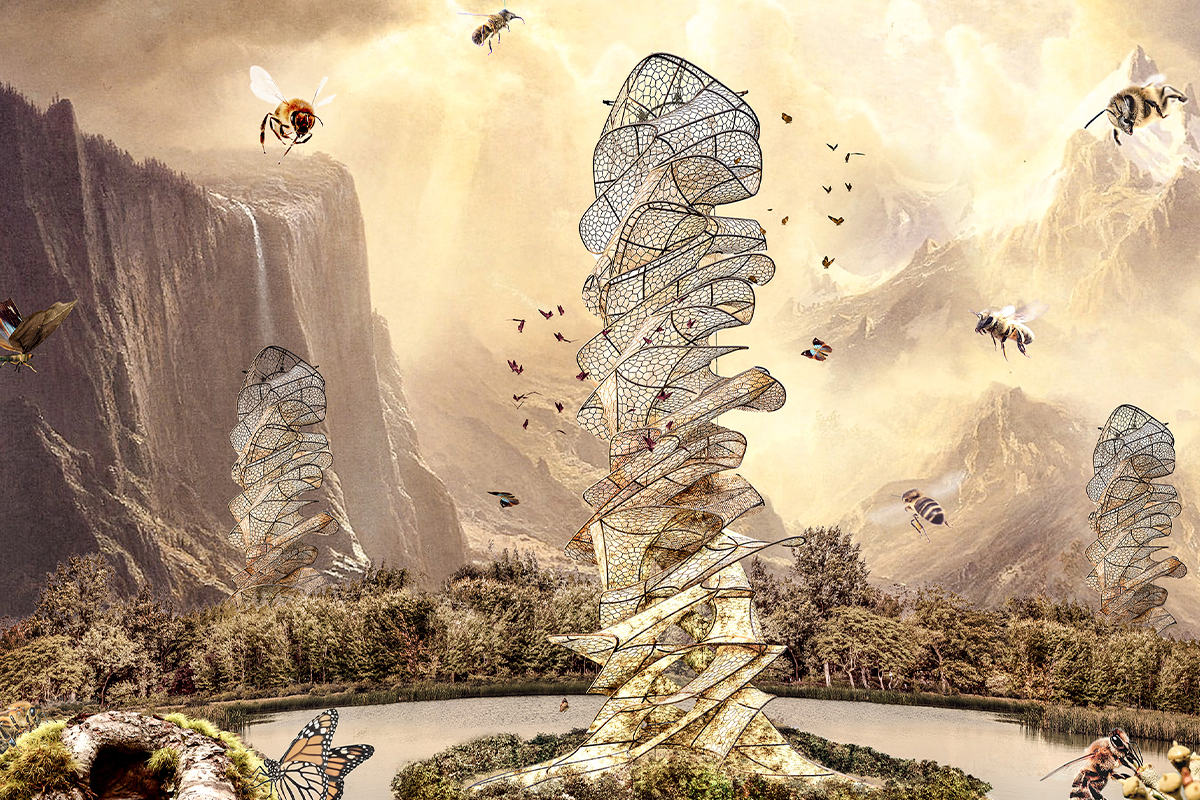
7Kviews
23 Innovative Skyscraper Designs That Were Selected As The Winners And Honorable Mentions Of The 2022 eVolo Magazine Skyscraper Competition
eVolo Magazine has announced the best skyscraper designs for the 2022 Skyscraper Competition. From a total of 427 projects received, the jury has selected 3 winners and 20 honorable mentions that demonstrated mastery in using technology, materials, programs, aesthetics, and spatial organizations.
eVolo is an architecture and design journal dedicated to technological advances, sustainability, and innovative design for the 21st Century and it has been hosting the Skyscraper Competition since 2006. As the organization described on its website, its objective is to "promote and discuss the most avant-garde ideas generated in schools and professional studios around the world. It is a medium to explore the reality and future of design with up-to-date news, events, and projects."
Scroll down for the majestic skyscraper designs! Let us know what you think about them in the comments and upvote your favorite ones!
More info: evolo.us | Instagram
This post may include affiliate links.
Tsunami Park Skyscraper
Wang Jue, Zhang Qian, Zhang Changsheng, Li Muchun, Xu Jing, China
Second Place
2022 Skyscraper Competition
"People are often afraid of tsunamis. Technological advances have not led to sufficient measures to withstand tsunamis. When a tsunami strikes, people are still helpless. The Pacific Rim, which is linked to all four major tectonic plates, has the highest tsunami rate in the world, with more frequent undersea fluctuations. For example, the volcanic eruption in Tonga on 14 January 2022 resulted in a tsunami threat to the entire Pacific Rim region.
It is therefore envisaged that a skyscraper will be built in front of Tonga’s long and narrow coastline. The aim was to reduce the biological and ecological damage caused by the tsunami. We use the edge wave effect of tsunamis to advance the tsunami wave so that the building is in the sea to dissipate it when it has not yet inundated the city.
Mangroves are woody plant communities in the intertidal zone of tropical and subtropical coasts, with developed root systems and staggering growth, which have the best effect on tsunami mitigation. Therefore, the skyscraper is inspired by the principle and mechanism of mangrove resistance to tsunamis, and consists of a single unit aggregated to form a vast complex along the coastline. Each cell consists of a bottom pillar and a top multi-level platform. The bottom pillar is made up of thick concrete columns that form a porous structure to dissipate the enormous force of the tsunami, while the upper platforms are of varying sizes, heights, and interconnections to carry people’s lives.
This skyscraper has two functional states, the normal state, and the disaster state. In the normal state, at the lower end of the columns, which is at sea level, people can use the space between the concrete columns for tidal fishing and water bazaars. This is where recreation, gathering, and fishing take place. And when a tsunami hits, the upper part of the building functions to absorb the waves of the tsunami. Each level of the building has a water cistern, and the absorbed water is transferred through columns to the underground desalination area for treatment. The underground desalination area is also capable of desalination and energy conversion during normal conditions, using the ebb and flow of the tides. Our solution strategy is therefore to turn a disaster into something, which means conforming to the tsunami, rather than fighting it. Transforming the catastrophic nature of the tsunami into a gift from nature to mankind.
The terrace at the top of the building is a ‘garden in the sky’ where people can relax and enjoy themselves. Low shrubs, gardens and water cisterns are planted on the terrace to provide a degree of amenity and dissipate the power of the tsunami. When a tsunami strikes, the high level of the platform becomes a safe place, making it a perfect place for people to ‘watch’ the tsunami and, in this relaxed way, to be less afraid of it. The interior of the building is a place for cultural activities for the local population, for exhibitions to enrich people’s lives, and for the storage of first aid supplies to ensure that people are well supplied in the event of a disaster.
Each of the concrete columns has a complex structure inside that allows for the collection, storage, purification and transport of the water, as well as vertical traffic. The seawater from the tsunami is collected by the concrete columns and transported underground to the bottom of the complex, where it is desalinated by the purification facilities placed there and then transported inland via pipelines, thus ensuring that water resources are scarce in the aftermath of the tsunami."
Beeswax Skyscraper: A Tower Made By Cooperating With A Swarm Of Bees
Chien-Ching Su, Taiwan
Honorable Mention
2022 Skyscraper Competition
"Insects, accounting for 80% of animal life on Earth, are the most diverse and largest group on Earth. However, both their diversities and numbers are declining around the globe due to habitat loss, pollution, and climate change. Without effective conservation measures, not only food shortage becomes serious because lots of pollinators disappear, but the whole ecological balance on the planet will break. The main goals of the project are to conserve insects’ diversity and restore their population. With artificial frameworks and the help of bees, the high-rise structure will be built as an insect habitat.
The inspiration for the design comes from a Slovakian Artist, Tomáš Libertíny, who cooperates with a swarm of bees to create many striking sculptures. The most famous beeswax sculpture in his works is the Nefertiti bust, finished by 60,000 bees cooperation. The question is – how does he produce these works “made by bees?” Firstly, he prints a 3D artificial framework of the sculpture, which encourages bees to build their hive above the framework. Then, he spreads some sugar to help worker bees work efficiently. After a while, bees will complete a striking sculpture made with beeswax.
The following steps are crucial to finishing the beeswax skyscraper. First, build the main construction to reinforce stability. Second, 3D printers will print frameworks within the structure. Then, bees will start to make honeycombs above the framework. We can say the construction work has already finished here; however, several amazing things will happen in the wake of the construction. As time goes by, the old beehives will gradually decay; bees will migrate to the higher location of the skyscraper since the decayed hives are unsuitable to live. The decayed beehives will be decomposed by different germs to become soil parent material; The fertile material contains 17 essential elements for plants. Therefore, some pioneer vegetable species start to root in the building; Gradually, more and more diverse ecological communities will form, and the healthy environment will become many kinds of insects’ habitat. Give insects more chance to survive."
Sanctuary Above The Tomb: Inhabiting Radioactive Marshall Islands
Xueer Wang, China
Honorable Mention
2022 Skyscraper Competition
"The inhabitants of the Marshall Islands are the most direct victims of the two major threats facing humanity-nuclear weapons and climate change. Between 1946 and 1958, the United States detonated 67 nuclear bombs on, in, and over the Marshall Islands, expelled hundreds of people from their homes, and buried more than 3.1 million cubic feet of radioactive soil on one of the atolls, covering it with cement-forming what the locals call “The Tomb”. For decades, the residents of Marshall depended on foreign aid to survive.
Nowadays, climate change and sea-level rise not only accelerate the leakage of radioactive materials but also bring new threats to these indigenous people. a self-sufficient community system that provides clean water, food, and adequate infrastructure must be provided to the local residents.
This is a radioactive material recycling system based on the ability of certain fungi and plants to absorb radioactive and heavy metal materials and produce organic matter and energy, providing clean water, food, and adequate infrastructure for the residents.
The outer skin is derived from the outer membrane structure of the cell wall of radiodurans, in which there is a surface layer composed of protein subunits arranged in a hexagonal shape, which has the function of support and protection."
Air Purification Skyscraper
Zelun Wang, Shengwu Fan, Manqian Lin, China
Honorable Mention
2022 Skyscraper Competition
"Nine out of 10 people around the world breathe polluted air, according to a report released this year by the World Health Organization. Indoor and outdoor air pollution causes 7 million deaths worldwide each year and is responsible for 24 percent of stroke deaths, 29 percent of lung cancer deaths, 25 percent of heart disease, and 43 percent of other lung diseases. Air pollution has become a major killer of human society.
More than half of the world’s most polluted cities are in India, with New Delhi firmly in the top spot. Pollution kills countless people in New Delhi every year. Especially in winter every year, PM2.5 index reaches 20 times the safe limit.
We believe that the ban and school closures issued by the Indian government cannot fundamentally solve the problem. Cities still need to develop and operate, and the generation of PM2.5 should be stopped at the source. We blame, therefore, the most serious pollution source——traffic pollution, traffic intersection are set on the city air purifier skyscrapers, the generation of PM2.5 four kinds of reaction gas absorption and filtration, prevent reaction PM2.5, at the same time can also be useful, useless to the construction of power supply, to fertilize the vertical greening, The whole building forms a closed system to purify and regenerate polluted air."
Residential Flying Unit Nest Skyscraper
Mohammad Pirdavari, Portugal
Honorable Mention
2022 Skyscraper Competition
"The construction of a villa is considered a great way to facilitate vacation accommodations for any family, to easily frequent their trips. Site locations for villas are most of the time, a place in the heart of pleasant natural resources, which construction of a villa, would ruin the existing ecosystem. In addition, having a traditional villa will cost a fortune, which is multiplied considering the fact that people want to idealize their villa, as their dream house! Limitations of the construction industry, in terms of land use, and lack of access to distant places, are also insurmountable. These are all just a gist of the reasons why the construction of a villa should be revised meticulously. This design of mine is a state-of-the-art, idea, which is a great way to overcome these challenges and create a new exceptional viewpoint. A self-sufficient, flying unit, creates a totally different living experience for the residents, in which they are free to choose their ideal climatically destination, no difference how high or low, how cold or warm! An ideal accommodation, which does not add up the expenses, because it gets charged via the solar cells of the facade, and also via the connected nest. A brilliant, eco-friendly, idea that tears down mental barriers as well as economic and environmental limitations.
Numerous transferable units, located on a host building, creates a giant skyscraper, a vertical, energy-self-sufficient garden and residential complex which facilitates living in a dreamy house, at any other location, at any time, that could be another interpretation of Le Corbusier’s famous phrase: “a house is a machine for living” for the human of 21st century. I am pointing to a kind of high-tech architecture that enables the new generations to live in their dreamy house without any barriers to locating! Experiencing different seasons in different locations; in a wide variety of climates and sceneries, with almost no environmental cost, is a priceless gift to the architecture world."
Skyscraper Injects New Life To Tiankeng
Shuzhan Liu, Siang Duan, Yimin Gao, Jingyi Li, Shiliang Wang, Daxu Wei, China
Honorable Mention
2022 Skyscraper Competition
"The design site is located in a Tiankeng in Shaotong City, Yunnan Province, where villagers have lived for generations. According to a legend, the ancestors of the villagers in Tiankeng lived here in order to avoid war. With the development of the times, problems gradually emerged, causing many inconveniences to the local villagers."
Meru: Center For Organic Parallel Development
Karan Jain, Vishwal Ram Gowda, India
Honorable Mention
2022 Skyscraper Competition
"Meru, it means the abode of gods at the center of the universe, the project brings together the context with those inhabiting it. The goal is to create organic growth within a community by the usage of progressive improvements, sort of like how a frog doesn’t realize its being boiled in water.
Currently in Delhi, among many problems is the incredulous amount of waste that is produced by the city and in tandem with that, its relation and allocation with the slums of Delhi. Among the two the former isn’t being given enough treatment and the latter seems impossible without the displacement of a large population of people. After contemplation one thinks that such a feat is impossible without there being the availability of such a large vacant amount of space. But what one, can do in such a situation is to set up a situation of parallel organic growth, this allows for the infrastructure to creep into an area with such rich culture and history while also allowing the area to creep into the infrastructure allowing for both the former and the latter to develop off of each other, pushing the development of the context at an exponential rate.
To achieve this the context and the people within should be able to feed off of each other, and so the MCD dump yard in Bhalswa new Delhi seems like the perfect site as the dump yard has been accumulating waste for a long time and as such depreciating the value of anything around it, which in turn made it ideal for laborers and slum dwellings to develop.
In order to reverse this, the choice was made to set up factories on-site to recycle all the waste within the dump making it suitable to build and live on while also increasing the value, furthermore the plans then move on to the introduction of infrastructure which enhances the quality and culture of the surrounding people. Now the surrounding people are meant to occupy this development and grow from it after which the settlement’s previous value decreasing factors such as the waste gets recycled for refusal allowing for the community to sustain itself and grow on its own and develop by itself organically.
The pace of the project itself allows for such an organic and comfortable growth. The end product is a skyscraper that acts as a sustainable city that has modern settlements growing around it."
The City Chloroplast: A Skyscrapers That Absorbs Co₂ And Converts It Into Starch
Kaiyu Chen, Yong Lin, Ziyi Li, Zhipeng Tao, China
Honorable Mention
2022 Skyscraper Competition
"Over the past years, the environmental issues due to carbon emissions have been the focus of many countries around the world. The emissions in North America and Europe have been stable, while the developing countries in Asia, South America, and Africa are facing increasing air pollution problems with economic growth and urbanization.
Similar reasons caused the increased carbon concentration in different countries. Rapid urbanization brings a higher demand for electricity and heating, and the CO₂ emissions from electronic appliances/equipment and transportation are the major sources of carbon emission.
In order to address the environmental issue due to greenhouse gas emissions, and to improve our living conditions, different countries are applying various methods to eliminate carbon emissions and improve air quality. The Chinese government is advocating the carbon emission control policy, proposing the strategic goals of “Carbon Peak” in 2030, and “Carbon Neutrality” in 2050.
In September 2021, the Chinese scientific research team presented a chemical-biochemical hybrid pathway for starch synthesis from carbon dioxide (CO₂) and hydrogen in a cell-free system. The artificial starch anabolic pathway (ASAP), consisting of 11 core reactions, was drafted by computational pathway design, established through modular assembly and substitution, and optimized by protein engineering of three bottleneck-associated enzymes.
In our skyscraper design, we designed different parts of the skyscraper, combining the steps and processes of carbon dioxide collection and capture, transportation, storage, and eventually starch production. The special membranes that collect and separate carbon dioxide are distributed in the main structure of the skyscraper. The collected and separated carbon dioxide will be transported across a huge transverse pipeline to a huge circular space for storage. A series of devices for the synthesis of starch from carbon dioxide (CO₂) and hydrogen are distributed in a large annular space. All the energy needed to run the equipment comes from the large circular rooftop solar panel."
Climate Control Skyscraper
Kim Gyeong Jeung, Min Yeong Gi, Yu Sang Gu, South Korea
First Place
2022 Skyscraper Competition
"The two risk factors that will come to mankind over the next decade are “Climate crisis” and “failure to respond to the climate crisis”. 2019 was confirmed as “the Second warmest year in history”. Experts are referring to the end of the Earth as 2050 due to the abnormal climate. From the beginning of the 21st century to 2021, the average temperature of the Earth’s surface rose by 0.93 ±0.07’C, which is more than two-thirds of 1980. (It is increasing by 0.13 degrees to 0.25 degrees every 10 years). Due to the increase in temperature, the global village is currently facing various natural disasters and environmental problems. There are various damages, the most serious damage of climate change to extreme drought and desertification caused by drying up long-term. Of course, reclamation of forests, and man-made factors such as environmental pollution and deforestation have conspired to happen, but desertification due to global climate change is accelerating. Despite these global movements, environmental disasters and desertification around the world are still rising exponentially, and some experts say that environmental problems have already progressed a lot. In other words, awareness and policy on environmental issues are important nationally, but a movement to solve environmental problems through a groundbreaking technological and architectural approach is needed and should be applied worldwide. Then, how can we architecturally prevent desertification as well as persistent natural disasters? The answer lies in the ‘Climate Control Tower’. CCT is designed to cope with climate change and overcome the current climate crisis the world is facing. Through clouds generated by absorbing seawater, the climate crisis regulates the weather by raining where there is a drought, absorbing clouds where heavy rainfalls, or reflecting solar radiation.
CCTs are built above the sea for effective use of marine resources. CCTs anchored through subsea trusses import cloud seeds, chemical catalysts, and human resources through ports accessible in all directions. They also export materials such as sodium chloride and ionic substances obtained by electrolyzing seawater. The power consumed by this gigantic skyscraper is supplied by a solar panel roof and a wind pressure generator on the lower level of the building. The heat generated by the solar energy is transferred to the high-temperature pressure tank inside the cloud generator and is used to make pure water by synthesizing hydrogen and oxygen molecules extracted from seawater. Water moves upward in the form of water vapor and passes through a wind pressure generator, generating electricity through wind power generation by pressure difference. Water vapor moving upwards is sprayed around the skyscraper in the form of clouds and stored in a membrane controlled by a control ring. The laboratory located inside the CCT transmits meteorological observation information to the control ring through communication with the CCT Weather satellite, which is floating in space. It calculates the movement of clouds according to the wind direction and distance so that they can reach the target area. As the wire of the control ring rotates and contracts, the cloud is discharged through the outlet in the middle of the membrane, and the control ring dispatches the drone unit with it."
Urban Condenser
Yunheng Fan, Baoying Liu, Rongwei Gao, Junliang Liu, China
Honorable Mention
2022 Skyscraper Competition
"Urbanization is an important symbol of a country’s transition from a backward agricultural society to modernization, and China is undergoing an important transformation of urbanization. Migrant workers, a discriminatory and self-contradictory title, deeply reflect their status of “marginal people,” the main force of urban construction in China. They work in cities but do not have urban hukou, or household registration, and do not enjoy social security. They make great contributions to the city, they yearn for the city, but are not accepted by the city and are free from mainstream society.
The migrant worker community gathers these workers (often called “drifters”) together and the collective living allows them to gradually blend into the society. At the same time, the Urban Condenser serves as a cohesive device for the city, allowing urban residents and migrant workers to intermingle. With community, city, migrant workers, residents, and other dimensions of identity as the object, and with lifestyle, tourism, community mechanism, and other connections within the community as the link, the Urban Condenser builds a “super community” to stimulate social development.
“A huge frame rises in a city of monotony.” People stop and marvel at the huge frame. Construction spreads through a large number of media, making migrant workers a new hot spot for people. Internet celebrities and tourists gradually enter the building, and their curiosity makes two people who originally lived on different tracks meet each other. Tourists travel with their own stereotypes about this group, but their expectations are shattered by the reality in front of them. Migrant workers create their own culture in the societal limbo — new collectivism. In the whole process of metabolism of the architecture, the Urban Condenser utilizes the uniqueness of its architecture to fully display its function as a media. The watched—migrant workers—is not in a passive situation, and the viewer is not always condescending and without being aware of his/her own rights. The community reshaped the perceptions and relationships of both groups, making their interactions more enriching and benign. The Urban Condenser is only the epitome of the urban dream of 300 million migrant workers."
Nice green space that's totally not safe to be in, because of thing falling on your head.
New Spring: Agro-Ecological Skyscraper
Michał Spólnik, Marcin Kitala, Austria, Poland
Third Place
2022 Skyscraper Competition
"We live in a paradox – nowadays more food is produced than needed but the expansion of hunger is increasing. How is this possible?
Global food production relies greatly on an extremely small number of crop and livestock species. Grains are married to particular chemicals, becoming vulnerable to environmental changes, and lack immunity. Together with changes in how land and water resources are used, population growth, urbanization, and shifting food culture, this lack of crop diversity poses a threat to global food and nutrition security. For the sake of our society – and for the ones to come – we might like to rethink the ways we treat our land.
The proposed skyscraper is a large-scale device that connects nature, science, and social fields. It is an aggregation of garden modules – each belonging to a particular biome, containing distinct flora, soil, microorganisms, small animals, and microclimate.
Following the principles of agroecology, each proto-garden is experimental from the start, often bringing together plants that do not come together in the natural environment. It is particularly important when fighting climate change, where some damages cannot be reversed and a new solution and adaptation are needed.
Modules are seeds of future gardens, fields, or farmlands. When one is requested it can be easily dispatched and shipped to the destination, where it will help to restore the natural landscape. Modules can be added, removed, or replaced freely.
Hidden behind the envelope of modules and their timber supporting structure is the core, filled with hardware functions – seed and plant tissue banks, laboratories, lecture spaces, data centers, warehouses, and high-tech composters. The program is completed with meetings, discussions, and knowledge exchange events.
Pods are made with cross-laminated timber, which allows agile fabrication and a relatively repetitive process of assembly and disassembly. Strains of CLT linear elements branch out from the core towards the pods – finding their way in optimized load-bearing bundles. Elements of ladders placed upon particular elements stimulate activities of small animals, that roam around in their floating garden."
Fung(S)i: The Vanguard Of Habitat Restoration
Christopher Tanihaha, Vincentius Kevin Aditya, Arnetta Hamijoyo, Christina Putri Larasati, Evan Januar, Gavrila Mandy Kahuni, Eugenia Jessica, Felia Alexandra Linoh, Luciana Augusta, Gregorius Christian, Reynaldi Daud, Indonesia
Honorable Mention
2022 Skyscraper Competition
"Sinking land has become inevitable. It is mainly caused by the increase of seawater level and got worse by the decreasing underground water table that is happening simultaneously. Sinking land causes land scarcity which makes coastal residents around the world lose their homes. According to BBC News in 2018, the fastest-sinking city in the world in Jakarta, Indonesia. Jakarta is sinking by an average of 1-15cm a year and nearly half the land now sits below sea level. The dramatic rate of sinking is partly down to the excessive extraction of groundwater for drinking water and everyday hygiene purposes by city dwellers. Piped water is not reliable and hardly available in most areas so people have no choice but to resort to pumping water from the aquifers deep underground. So the main goal is to be a buffer that acts as a vessel for ex-dwellers of the sinking city that also provides potable water for the remaining citizens on land at the same time.
Our project here helps achieve this goal with two approaches. Firstly, the submerged zone provides water supply for the people of Jakarta by filtering seawater through a reverse osmosis system. This process starts with the seawater entering the building through a pump directly attached to the pre-sediment filter zone. The seawater then gets filtered once again using carbon and then passed through a membrane to conduct reverse osmosis. Reverse Osmosis works by using a high-pressure pump to increase the pressure on the salt side of the RO and force the water across the semipermeable RO membrane, leaving almost all the dissolved salts behind in the reject stream. Clean water gets distributed to the dwellings above, and some get transferred back to the city of Jakarta to supply the remaining residents so there will be no need to extract more groundwater for everyday purposes. Second, the floating zone provides living space for the citizens who lost their homes.
The submerged and floating zone connects to one another creating a fungi-like platform for the dwellers. As fungi are known to be able to thrive even in the worst circumstances, Fung(s)i also aimed to be able to sustain the worst environmental challenges possible. This project uses a modular configuration that makes it possible to be built in any part of the world and uses the Voronoi structure which takes after aesthetically pleasing features and structural objects found in nature. This structure divides the space into smaller spaces organically. It also creates a natural pattern in the building’s facade and saves more space in the building itself. The Voronoi cells also contribute to energy saving, since it allows natural light inside the building.
As its main goal is to stall the complete submergence of the city before the citizens have the chance to escape, it has contributed to sustaining countless aspects such as environmental by omitting the need to pump potable water from underground and social-cultural-economic by creating a new living “ground” to sustain humanity in the future."
Tree Skyscraper In South Sudan
Ron Krakovski, Talia Tsuk, Israel
Honorable Mention
2022 Skyscraper Competition
"The main purpose of The Tree skyscraper is to provide accessible water to the villages of South Sudan. The Tree unifies the new community while providing it with water for agriculture, sanitation, and everyday needs.
South Sudan is located in northeastern Africa; it gained independence from the Republic of Sudan in 2011, making it the latest nation to be recognized by the United Nations. Conflicts have undermined the developmental gains achieved since independence and worsened the humanitarian situation. As a consequence, South Sudan remains caught in a web of fragility, economic stagnation, and instability a decade after independence. Poverty is ubiquitous and has been reinforced by a history of conflict, displacement, and shocks.
59% of the population of South Sudan lack proper access to clean water sources. Constant conflict and civil war, which began in 2013, Have led to the current water crisis in South Sudan. During the war, the nation’s water systems were deserted and demolished. 1 in 3 people use contaminated water daily, increasing the risk of infection by waterborne diseases. Currently, in South Sudan, 77% of children under the age of five die from diarrhea.
Water is essential to the function of every life form. We believe that providing every village with access to clean water gives them a fair opportunity to develop their lives in every aspect. The Tree skyscraper provides aid for every village and organizes the community around it. It serves as a clean water source, enables education, and provides job opportunities that can help the South Sudanese to flourish as a people and community.
The building is connected to the natural aquifer Which fills it year-round; during the dry season using hot air condensation, and during the wet season by using rainwater. The building draws water from the filled aquifer and supplies the village with running water due to the communicating vessels theory that relies on the idea that water runs from a high source to lower zones.
South Sudan has a tropical climate; it has a rainy season from April through December that receives a rainfall of 750–1,000 mm annually. During the dry season, the air is extremely humid, and the dew point is low, which means that condensation happens more readily.
The water that is collected goes through the water cycle: Water is collected by the condensation tank, drainage, and the aquifer; then, the water is pumped to the main water tank that is located in the center of the building. Due to the communicating vessels, the water tank supplies the village with clean water. Wastewater from the village is being purified before it runs back to the main tank.
The interior of the building has wooden floors supported by metallic rails, dynamic partitions make out the spaces for any purpose and can change along the floor’s rails. Along with the building are different functions provided for the community’s use: A crops storage, a sanitary clinic, professional education, and a mechanical area for maintaining the building’s systems. The Tree helps the community gain education and also provides job opportunities.
The outer facade is installed on the inner structure, the facade is made of bamboo and transparent solar panels supplying the essential systems with electricity. The building combines the traditional housing method of Tukul housing in South Sudan with modern techniques and materials."
Adapting Obsolescence
Ahmed Helal, United States
Honorable Mention
2022 Skyscraper Competition
"Since the construction of the Equitable Life Assurance Building in 1820, the office tower has become synonymous with white-collar productivity in New York City. In the subsequent 200 years, some 450 million square feet of office space has been constructed in the five boroughs, constituting over 10% of all office space within the United States. It wasn’t until the proliferation of the internet, collaborative communication platforms, and co-working spaces, that the office began to decentralize. Then, in 2020, the Global Coronavirus Pandemic completely disrupted the corporate hierarchy, as White-Collar America transitioned to working from home, it became evident that the workforce could remain productive outside the office. It is now clear that there will never be a full return to pre-Covid workplace normalcy. This paradigm shift has rendered the commercial office tower obsolete. If this typology no longer holds value, then what should we do with the obsolete building stock? To simply demolish it would be wasteful, arrogant, and short-sighted, for two reasons. First, all constructions have inherent value simply in that they exist and were an expenditure of finite resources that can never be replaced. To dispose of them is to erase those resources forever. New York City alone produces over 3 million tons of construction waste annually, only 35% of which is returned to the production stream. Second, it is precisely this outdated building stock that gives New York its identity. The only path forward is adaptive reuse – to transform these antiquated buildings into vibrant and essential structures that serve to alleviate the two fundamental architectural crises in the city: housing and public space. – This proposal is an example of adaptive reuse design, changing landmarked office skyscrapers like the AT&T Building by Philip Johnson, currently known as 550 Madison, to residential spaces that prioritize tenants and the local community, offering an accessible well-rounded live, work, and play lifestyle through the design and programming of homes and public spaces."
Adobe Farm Skyscraper
Hamidreza Esmailnazari, Hosein Mosavi, Amir Hossein Saeedi Majd, Hossein Amery, Hossein Arshadi Soufiani, Ali Jamali, Maryam Baharvandi, Sweden
Honorable Mention
2022 Skyscraper Competition
"Isfahan is a city in the middle of the desert in Iran and it is situated on the north side of the Zayandeh River. The city retains much of its history, which has developed between the 9th and 18th centuries. It is famous for its Persian architecture and its history.
For centuries Isfahan city had been an oasis settlement, by dint of its surrounding fertile lands and prosperity. After the 1980s, the demand for water for industrial usage has raised gradually. The creation of large steelworks and other new industries along with the growing population, disable the scarce water resources to be utilized primarily for agriculture and now, the Zayandeh River cannot supply all the agriculture’s land anymore. The farmers in Isfahan have protested against the diversion of water from the Zayandeh River to supply other areas, leaving their farms dry and threatening their livelihoods. The violent crackdown on protests was answered to them by the government in 2021. From another point of view in this historical region, which has extreme weather, architecture ways widely used for finding passive ways to solve relation between humans and nature. These architectural ways are bound with the culture and identity of the local people. Their lifestyle has formed inside different types of shelters to protect them in extreme weather situations.
By focusing on Isfahan’s farmer’s lifestyle and their special culture as a subculture, two criteria point comes into the picture. First their dependence on the Zayandeh River and then their unique process of producing high-quality organic fertilizer that comes from Dovecote’s house. Traditional Dovecotes in Isfahan were designed to produce large quantities of organic fertilizer for helping to farm in the middle of the desert and it was part of the traditional way of farming in Isfahan.
In the central void of Dovecotes, thousands of holes were placed into the walls continuously for pigeons. The architecture method used in Dovecotes provides a suitable environment situation for pigeons in the middle of the desert in a passive way. The used material was unbaked mud brick plastered with mud. Timber was also rarely used. Zayandeh River as the most important criterion is not able to supply all agricultural lands, which are placed along the river anymore, due to its low water flow. On the other hand, new technology in agriculture such as hydroponic provides cultivation with less usage of water. This project is a combination of a traditional architecture way, which provides a suitable environment in a passive way, and a layer of technology for solving the scarcity of water.
Agriculture’s landscapes transformed into a skyscraper for answering the desire of local farmers in Isfahan who are forced to leave their farms. Dozens of agricultural lands combine together in one closer location to the Zayandeh River for having access to the water. The skyscraper is formed by the combination of a traditional architectural passive way, which facilitates living in the middle of the desert, and a layer of technology that provides agriculture with the minimum usage of water. Horizontal surfaces transformed into vertical surfaces. For solving light issues in a closed vertical environment, the transformation occurred by optimizing geometry according to the result of calculating the incident radiations and the amount of renewable energy that can be collected from photovoltaic or solar thermals.
The skyscraper retains the identity of its context; it is sustainable and tries to protect farmers in Isfahan. It is open to the wind for providing a suitable environment situation inside. It creates enough shadows to protect agricultural products and farmers from the sun. To sum up, it will provide more suitable hours during the year for farming and it will help farmers of Isfahan to survive in this era."
We will be growing our food in big buildings near urban areas. It's just a matter of a decade or two.
Skyscraper For Open Pit Mines
Sacha Cudré-Mauroux, Nils Hayoz, Bart Oosterhoff, Thomas Wenzel, Switzerland
Honorable Mention
2022 Skyscraper Competition
"With more than one hundred open-pit mines in the world, a large area of the earth’s surface is unusable after closing.
Our skyscraper was designed for the pit mine of the Australian city of Kalgoorlie. This nineteenth-century city was created and shaped by gold mining and to this day the entire economy and identity operate on the mining of gold and nickel. When the mine is exhausted, and it is no longer profitable to continue the mining process, Kalgoorlie will have no future and will lose its identity.
We want to transform the former wasteland into the center of a vibrant city providing housing, public institutions, green space, and agricultural areas like an oasis in the desert. The unique properties of the given topography open opportunities for a new and sustainable way of living. We use the thermal mass of the benches to provide thermal comfort to buildings and use different soil layers for multiple functions such as living, recreation, and agriculture while giving space to the people, increasing biodiversity, and restoring the natural water cycle.
Our new typology of skyscrapers serves as a vertical street connecting the different layers of benches in the mine. At the same time, it houses public institutions and services. The building serves as the main tool for effective daylight management. The steep walls of the mine resulted in unique shadow effects during the day. Our skyscraper functions as a light guidance system providing the over-shadowed area with natural daylight when needed, protecting the over-heated areas from direct sunlight, and using this as a sustainable energy source in the summer months. The core of the skyscraper functions as a passive ventilation system for the whole community."
This might be a goer but Kalgoorlie is in a desert, hundreds of kilometres from anywhere. When water is such a problem, why would large numbers of people want to stay, live, invest in such a project?
Hyper-Mask Skyscraper
Yu Liu, Junjie Hou, Jiaxi Shi, Hailin Wu, Ronghui Yang, Jiang An, China
Honorable Mention
2022 Skyscraper Competition
"Before the COVID-19 pandemic, masks were one of the most reliable and direct methods for people to deal with urban air pollution; in the past two years, with the outbreak of the COVID-19 pandemic, the portability of masks and their impact on blocking the entry of air through breathing makes it a must-have for people traveling.
With the development of China’s industry, the frequency of China’s urban PM2.5 index exceeding 400 has increased. Masks can effectively reduce the number of harmful substances people inhale when exposed to a high PM2.5 index.
The extensive use of disposable masks also brings pollution problems. First of all, the raw materials of masks are mainly non-woven fabrics made of high melting index polypropylene materials. This material is derived from petroleum, which will cause air pollution during the production process; secondly, waste masks will flow into the sea with rainwater without incineration, threatening the marine ecological balance.
Building space has been a place where human beings gather to engage in production and living since ancient times. How to reduce the pollution of masks to the environment while making more people less affected by COVID-19、PM2.5 and pollution through architectural design?
From this, we think that adding a membrane to the whole building can filter air is like putting a mask on a human being, so as to achieve the purpose of isolating and filtering indoor and outdoor air. At the same time, in order to improve the interior air circulation, we make the building blocks move in the horizontal direction that can pull the membrane structure to shrink and relax, changing the air pressure in the membrane. When the air pressure in the membrane is lower than the external air pressure, the urban air which is filtered and purified by the membrane and the bottom device enters the building; when the air pressure in the membrane is greater than the external air pressure, the exhaust air filled with CO2 and other substances inside the building passes through the building. The exhaust air was purified, filtered, and discharged into the urban environment passed by the plant spaces and the roof garden.
Based on this idea, we have carried out a series of building space combination experiments and carried out membrane covering experiments for different building space combinations, to explore more space combination possibilities. After many experiments, we finally determined the track size and position of the building blocks that change the volume of the membrane structure. Through experiments, we found that the movement of multiple large blocks can effectively change the volume of the membrane. At the same time, we found that part of the space inside the membrane will not be affected by the volume change of the membrane, and this part of the space will be used to arrange living space units.
This skyscraper design first decided to use the steel truss for the overall structural system. The design centralizes all urban public activity spaces to form multiple large space blocks. The design distributes the large space blocks evenly throughout the whole space and reasonably sets the movement trajectory so that they can maximize the volume change of the membrane. The design determines the shape of membrane changes by simulating the movement of large public blocks. The design distributes a large number of residential blocks in the space that is less affected by the volume change of the membrane. The design uses a generative algorithm to attach the structures required for the living space units to the truss structure. At the same time, the design distributes the green space units between the large public space units and the living space units, and the design hopes to connect all the space units. These green spaces not only connect various spaces but also purify and filter the air entering the membrane. The design places a large green space at the top of the building. This large green space can re-purify the air in the membrane, so that clean air can enter the urban space from the membrane space."
Best of all, develop non polluting versions of industries so this is not necessary.
Cure For Desertification Skyscraper
Wanjing Wang, Zhenhao Chen, Minghui Sang, Xiaoran Xiong, Kaifeng Fan, China
Honorable Mention
2022 Skyscraper Competition
"According to reporters, Dunhuang’s first and last green barrier against sand storms run by Dunhuang Yangguan forest farm, which once owned about 20000 acres of Forests belt, has encountered large-scale “shaved head” in recent ten years. The sweat of several generations of local people have wasted, and the ecological disaster of “green retreat, sand advance, desert pressing” reappears in Dunhuang.
All the protective forest lands cut down in the forest farm are used to plant grapes with high water consumption and frequent disturbance of the surface soil layer. At present, grape production has become the pillar industry of the forest farm. However, the problem is that after planting grapes, it will not only fail to prevent and fix sand but also may consume the scarce water resources and aggravate the risk of desertification.
So we come up with the consumption- how can we galvanize the local economy and achieve the betterment of people’s lives without aggravating sand storms and harming present forest barriers through the form of skyscrapers?"
City Healer Skyscraper
Wang Changsi, Guo Fang, SiYuan Zhang, China
Honorable Mention
2022 Skyscraper Competition
"With the continuous expansion of the city scale and the continuous increase of the population, the “urban diseases” that are similar in the major cities have appeared. This design focuses on the problem of urban ecological distribution and utilization. The architect hopes to make the city natural through his own design. The organic combination of ecology and urban human ecology will form a self-sufficient urban ecological system that can make full use of clean natural energy to realize residential, office, commercial, and transportation activities.
The design is firstly designed as a single unit based on the needs of residents and is divided into two main functional systems: commercial and residential. The monomers in the two systems are designed separately, but they all follow the same rules: the spatial arrangement of the monomers is carried out through a parametric program, and all the monomers will be logically searched for their 3D spatial positions: 1. The secondary monomers are directed to Higher-level monomers that are close together, 2. The same monomers keep a sufficient distance, 3. There is a minimum distance between different monomers. Through these three logical building units, it will find its own reasonable position in the space. When the two systems are stabilized, structural reorganization is carried out to form a new complete system.
The monomers in the two systems are supported by a common large structural column, and the interior of the structural column serves as vertical traffic, connecting the buildings in series. According to the position of the monomer, the structural column extends into a petal-shaped cantilever structure to hold up the monomer and partially connects with the outer skin to realize the integration of the structure.
In order to ensure the living of users, the design will provide other service spaces, public activity spaces, and entertainment and leisure space. Design Different functional spaces are formed by designing different functions for several single prototypes. The functional spaces are organically combined through the connection relationship of the monomers."
Oasis-Æ2030: Desertification Restoration Protective Membrane
Han-Yu Lai, Wei-Qun Cai, Chun-Yi Yeh, Taiwan
Honorable Mention
2022 Skyscraper Competition
"In 2008 the FAO reported that 20% of all cultivated areas, 30% of forests, and 10% of grasslands are degrading. 52% of the land used for agriculture is moderately or severely affected by soil degradation and 12 million hectares of once productive land are lost to desertification per annum. Nearly 1.5 billion people depend directly on degrading land for their livelihoods, most of them in the so-called ‘developing world’. Land degradation leads to food insecurity which can, in turn, lead to conflict, migration, and inevitably, the loss of biodiversity. Less tangible, but no less significant is that the process of degradation not only erodes the land, it also corrodes the spirit of communities watching their homelands turn into a wasteland.
Desertification is the persistent degradation of dryland ecosystems by variations in climate and human activities. These drylands are home to over a third of the entire human population and they occupy nearly half of Earth’s land area. Some 10 to 20% of drylands are already degraded, and ongoing desertification threatens the world’s poorest populations and the prospects of poverty reduction. Therefore, desertification is one of the greatest environmental challenges today and a major barrier to meeting basic human needs in drylands.
Climate change and human overexploitation have led to a growing problem of desertification and land degradation. Oasis’s attempt to prevent direct contact between sand and dust from planting grounds by blocking dust from sandstorms in the desert has been prevented. The water is stored using an air filter converter in the center of the tower, and the water is distributed equally to the land by controlling a central control room at the top of the tower. Because desert areas have unstable climates and rapid environmental changes, Oasis changes according to different climatic conditions. The air and water filtration system will achieve the best benefits through contraction and linkage, and ultimately achieve the purpose of environmental restoration."
Connecting Skyscrapers In Hong Kong Through Infrastructure
Zheng Xiangyuan, China
Honorable Mention
2022 Skyscraper Competition
"The population of Hong Kong has shown a continuous growth from 7,185,996 in 2015 to 7,496,981 in 2020. People have built skyscrapers in order to create more space on limited land. In the beginning, skyscrapers do provide more space for people, but with the increasing population, the number of skyscrapers will continue to increase, and eventually, they will fill the land of Hong Kong. How are we going to create new space for people to use when we can’t build new skyscrapers anymore?
Hong Kong is one of the cities with the highest population density in the world, its population density is 23.8 times the optimal urban population density. Only 1,106.66k㎡ of land carries 7,496,981 people, Nearly 80% of them live in coastal areas, which make up only 15 percent of Hong Kong’s total area. Over the past decade, Hong Kong’s population has grown by an average of 0.8% per year. Hong Kong faces a very serious population problem. As the population continues to increase, the average living space of people will continue to decrease. How to create more space in a limited area has become a serious problem for us to think about.
Skyscrapers can effectively save the floor area. With the continuous increase of Hong Kong’s population, there are 333 skyscrapers in Hong Kong today, which ranks first in the world. But even though skyscrapers can provide more space than ordinary buildings, the average Hong Kong resident still lives in very little space. In Hong Kong, a city with very dense buildings, there will be some unused gaps between skyscrapers. We use these gaps to convert them into space that can be used by people. This method can provide more usable space in a limited area.
We insert huge pipes into the skyscrapers, and inside the pipes is space for people’s activities and transportation, which not only solves the problem of insufficient space but also strengthens the connection between buildings. The transportation system in the pipe will provide a new way for people to commute, and the streets will become less crowded. We call this Intubation. Intubation can make people move in the gap between skyscrapers and make full use of the unused space in the city.
The building itself is an independent existence, and there is not much communication between the two buildings. When an individual’s main activities are concentrated in one building, the individual may have no experience of entering the neighboring building. When Intubation connects two skyscrapers, people can more easily communicate with people in other skyscrapers through Intubation. Intubation can also be seen as a three-dimensional road network in the air, which can share part of the pressure from commuters on the streets.
Intubation passes through the gap between skyscrapers and connects them, like building a bridge between skyscrapers, which enhances the connection between skyscrapers. When the Intubation grows to a certain extent, they become a road network in the air. Intubation is divided into two structures, connecting pipe and residential pipe. The connecting pipe connects the residential pipe at the intersection, and the residential pipe is used for people’s activities. As the Intubation system grows, we can replicate multiple layers and connect the upper and lower layers through specific positions, because this part of the space has a vertical height.
A more efficient solution is that instead of replicating the layers sequentially as the Intubation grows, we can make the Intubation three-dimensional from the beginning and fill in unused spaces as the Intubation grows. When all the gaps in this area are filled, the Intubation cannot continue to grow. At this time, the space in this area has been used to the greatest extent. We can expand the Intubation to other areas."
Urban Bypass Surgery
Yi Liu, Baichao Wang, Hao Zhang, YiHui Gao, ZongHao Yang, Shiliang Wang, China
Honorable Mention
2022 Skyscraper Competition
"Changchun is one of the most important cities in China. At the beginning of the last century, urban designers of Changchun carried out the road network system with reference to the theory of Howard’s “Garden City”. The urban transportation in Changchun is a system formed by multiple city squares as the center and roads as the axis, which initially established the main roads in the urban area of Changchun, and this urban layout is still in use today.
With the economic development and population growth of Changchun, the advanced urban transportation system can no longer meet the needs of the city. Although the city square connects several main urban roads, it is very easy to cause traffic jams in the surrounding area of the square during the peak urban traffic hours. For many years, Changchun is one of the cities which has the highest urban traffic jam rates in China. The main framework of the city cannot be changed, and we urgently need to create a new method and model to solve this problem.
This design distributed a number of transportation centers in the busy urban squares in Changchun. The interior of these transportation centers includes an urban cable car system that extends in all directions, a three-dimensional green landscape, and a number of residential and commercial space units. People gather here and take the cable car to any parts of the city. The vertical green landscape system can absorb the automobile exhaust air. The movable and detachable residential and commercial units enrich the center’s commerce system and provide citizens with a convenient urban life.
The designed transportation center is located in all urban squares in Changchun city. This design takes People’s Square as an example. It is the largest and most representative urban square in Changchun. It is located in the geographical center of Changchun and has many roads radiating around it. The design selects three important roads separated by 120°as the main design axes of the transportation center. In addition to serving as transportation routes, these three main axes also serve as high-line green parks which can divide the surrounding area, extending to the top of the transportation center. The three main axes converge together and extend upwards, forming the whole shape of the transportation center. There are countless residential units scattered on the entire transportation center surface. The form of the units responds to the traditional rural dwellings in Northeast China, the units providing convenient and reliable accommodation for all people."
Regenerative Highrise
Haptic Architects, Ramboll
Tomas Stokke, Shonn Mills, United Kingdom, Singapore
Honorable Mention
2022 Skyscraper Competition
"The Regenerative Highrise is sited at Grønland, a multi-cultural inner-city borough of Oslo.
The proposed new highrise tower at Oslo’s Grønland metro station seeks to use large-scale development of the city as a means to repair or enhance the inner-city neighborhood. In the first instance, this is a site of unique potential, where the metro meets the river above and its adjacent cycle and riverwalk. As such the new tower becomes a vertical linkage of these existing and developing transport networks, most notably the increased use of the city’s waterways for electric ferries.
The tower structure reuses an existing highway viaduct at its base, creating active frontages spanning three levels: the canal and metro level; the high street, and the viaduct level. The base of the tower gives back to the city, providing cultural, leisure, and sports facilities for the inhabitants of the city. The highway viaduct is repurposed for leisure purposes, to ensure the embodied carbon of the existing structure does not go to waste.
The tower itself seeks to address the challenge of waste in the construction industry. Changing needs and standards often lead to relatively new buildings being demolished and rebuilt. The proposed tower employs regenerative design at its core, thus ensuring future flexibility for change.
A superstructure consisting of 3-story high structural decks, allows the tower to be reprogrammed over time. The triple-height sky villages are flexible and can accommodate a variety of uses, such as a single-story production space, two stories of office space, three residential floors, or even a row of terraced housing.
As the pandemic has shown, needs and requirements can change suddenly, and the built fabric needs to be able to respond accordingly. The uses of the Regenerative Highrise can be changed with ease, from offices to hotel, from residential to production or leisure.
The engineering philosophy is developed with the idea to maximize future flexibility and adaptability of the engineering systems.
The structural solution is founded on the concept of a “hard floor / soft floor” where the super-structure of the tower includes a hard permanent floor every three levels and then a free flexible volume above. The idea behind the “hard floor / soft floor” philosophy is to move away from the traditional static structures and to create a new typology of vertical urbanism.
The hard floors are envisioned as timber composite construction utilizing recycled steel frame elements and cross-laminated timber (CLT) floorplates. The vertical and lateral load carrying system is a combination of composite glue-laminated/steel columns and a precast concrete central core. The “soft floor” volumes will be infilled with modular plug-and-play living components that can include elemental structure and full volumetric prefinished elements.
The Building Services (MEP) solution is also designed to maximize the flexibility of the tower. With a hierarchy of centralized and decentralized MEP systems designed to maximize the flexibility of the tower. The centralized systems are limited to the key backbone utilities of power, data, water, and drainage with the remaining systems being housed locally on the “hard floors”. The “hard floor” MEP systems will include heating, cooling, and ventilation which will be plug-and-play prefabricated elements.
A key goal for the engineering systems of the Regenerative Highrise is a focus on lifecycle carbon management. The main structural frame is envisioned as a timber-composite structure, taking advantage of the benefits provided by green pre-cast concrete, recycled steel, and timber to reduce and sequester carbon in the structure.
Finally, the building is to be capped off with a new hilltop, offering Grønland the viewpoint and greenspace Oslo’s outer suburbs benefit from."
How many readers here would voluntarily reside in one of these beasts? How many here have ever inhabited a very tall urban structure? My worst home was atop a 6th-floor walkup tenement in NYC's Lower East Side, but as a commercial courier in San Francisco, I ascended many tall office buildings. I would not want to be stuck in such a high tower during a big earthquake, storm, or other bothersome event. Life in the woods, with telecommuting and home deliveries, is much more comfortable for us, even with occasional brushfires. YMMV.
Wow, some really great fantasy art here. I mean, people obviously have no idea how much energy solar panels actually generate, or how energy storage works, or how putting a bunch of turbines on the low part of a floating sky scraper is just a phenomenally bad idea, but the art looks good. Don't get me wrong, if you have the money and a reasonable place to put them solar panels are great, and if your power use is low to moderate (commercial or residential) and you have a good amount of space in usable for solar panels (space for a panel that will average 80% or better per 150 sq ft of used floor space) you should get some solar panels or at least push for them. Battery backup is becoming reasonable for both small and mid-scale residential and commercial projects... again, keeping things running is going to get harder in the next few decades and self reliance will help keep you out of the grab bag for reliable infrastructure. But self powered or power positive/co2 capture sky scrapers?🤥
How many readers here would voluntarily reside in one of these beasts? How many here have ever inhabited a very tall urban structure? My worst home was atop a 6th-floor walkup tenement in NYC's Lower East Side, but as a commercial courier in San Francisco, I ascended many tall office buildings. I would not want to be stuck in such a high tower during a big earthquake, storm, or other bothersome event. Life in the woods, with telecommuting and home deliveries, is much more comfortable for us, even with occasional brushfires. YMMV.
Wow, some really great fantasy art here. I mean, people obviously have no idea how much energy solar panels actually generate, or how energy storage works, or how putting a bunch of turbines on the low part of a floating sky scraper is just a phenomenally bad idea, but the art looks good. Don't get me wrong, if you have the money and a reasonable place to put them solar panels are great, and if your power use is low to moderate (commercial or residential) and you have a good amount of space in usable for solar panels (space for a panel that will average 80% or better per 150 sq ft of used floor space) you should get some solar panels or at least push for them. Battery backup is becoming reasonable for both small and mid-scale residential and commercial projects... again, keeping things running is going to get harder in the next few decades and self reliance will help keep you out of the grab bag for reliable infrastructure. But self powered or power positive/co2 capture sky scrapers?🤥
